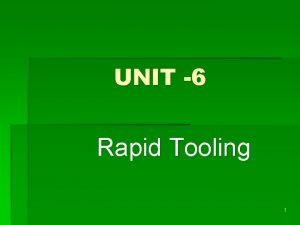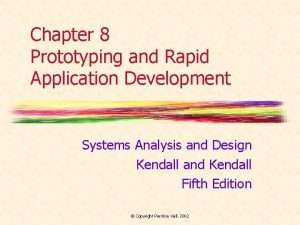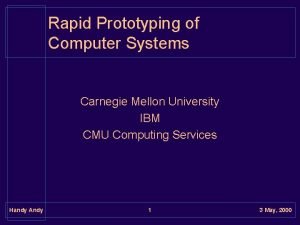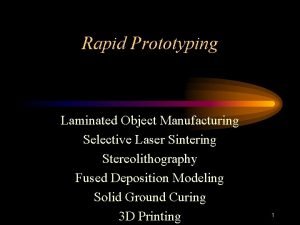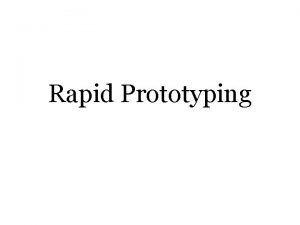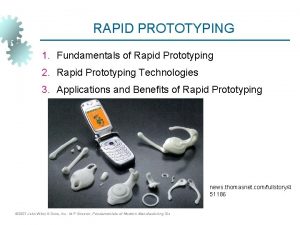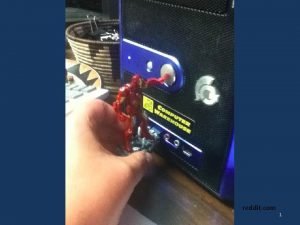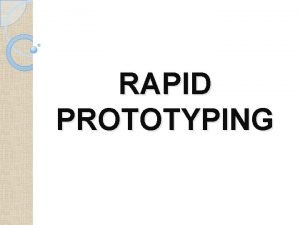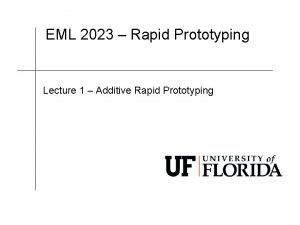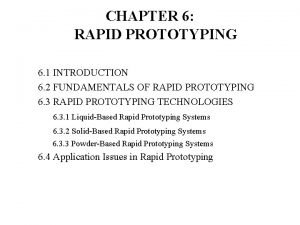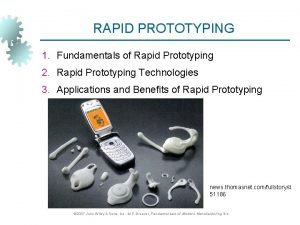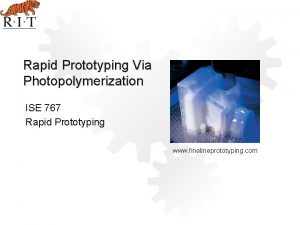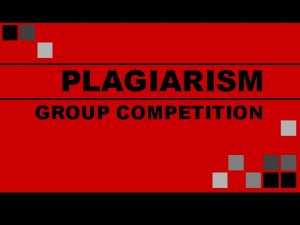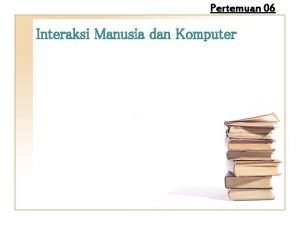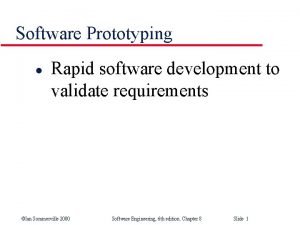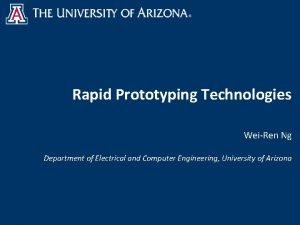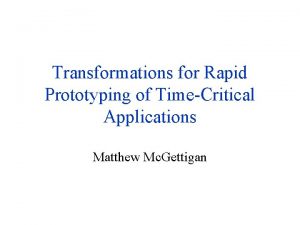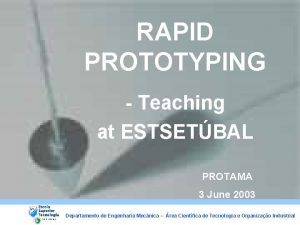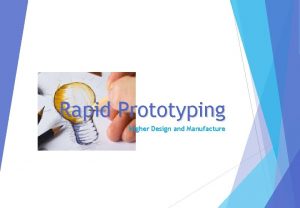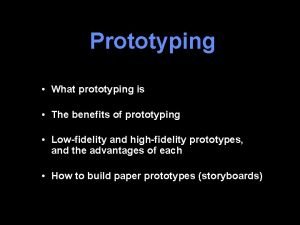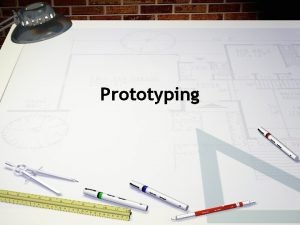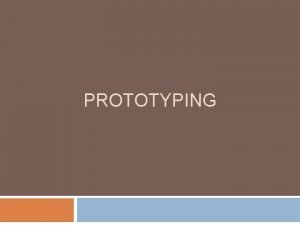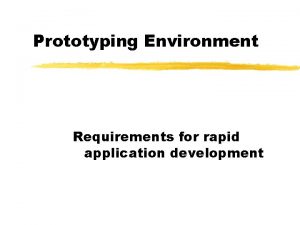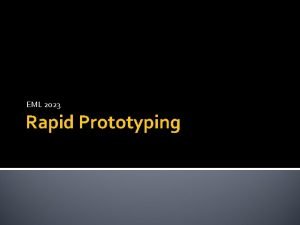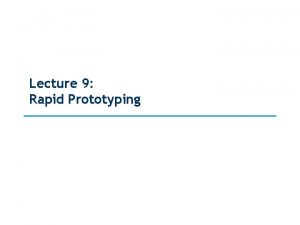Transformations for Rapid Prototyping of TimeCritical Applications Matthew


















- Slides: 18

Transformations for Rapid Prototyping of Time-Critical Applications Matthew Mc. Gettigan

Software Requirements • Can integrate web services, components and legacy software inot a functioning system • Must be operational before deadline and remain operational until expiration time • Must satisfy user-specified timing constraints

What Is Rapid Prototyping? • Goal is rapid development and information feedback • Done at the expense of efficiency and completeness • Allows for making changes early in the development cycle • Expectation that the model will eventually be thrown away

Application Software Approach • Objects are called Tele-Action Objects (TAO) • Each TAO is enhanced by an index cell (IC) • Objects may contain multimedia data • IC system is an active index that enhances the overall intelligence of the software

Technologies Used • IC cards • IC system (active index) • Relational Mining for appropriate web services • Petri Net • Time Management techniques

Rapid Prototyping Environment User/develope r IC Card Management IC Card System XMLjcc Multimedia Knowledge Eclipse Environment XMLjcx IC Software Engineering Environment Knowledge-Base Fig 1. 1 Code

IC Cards • User/developer’s specification of an active object or agent • Active objects interact with each other according to certain interaction patterns • IC Card Management System provides a way to organize and manage IC cards

IC Cards Fig 2. 1

Sample IC Card XMLicc Schema <ic. Card ic. Name="Patient Emergency Alert" ic. Description="Patient alerts network/database of emergency" ic. Int. Pattern="myselfwith" ic. My. Task="Alert network/database of emergency" ic. Time. Critical. Condition="Tc+Talarm > Ts > Tc+Tnormal: Talarm=2*smallest system granularity, Tnormal=smallest system granularity" ic. Id="3" ic. Number. Current="1" ic. Number. Total="1"> <ic. Other. Name="Network/Database" ic. Other. Message="Emergency Alert" ic. Other. Task="None" ic. Other. Id="-1" /> </ic. Card>

Multimedia Knowledge Eclipse Environment (MKEE) • Visual editor for the IC system • Provides modeling of multimedia applications and knowledge owned by multimedial objects • Generates XMLicx specifications of the IC system and used as the front end for the ICX compiler

Index Cell Structure Fig 3. 1

Sample IC System Fig 3. 2

Sample XMLicx Schema <? xml version="1. 0" encoding="UTF-8"? > <ic: ic. System xmlns: xsi="http: //www. w 3. org/2001/XMLSchema-instance" xmlns: ic="http: //www. mke. org/ic/"> <index. Cell id="ic 1" max. Life. Time="inf" name="Sensor"> <state id="state 0" type="entering" name="send"/> <transition id="trans 0" source="state 0" target="state 0" type="internal"> <message xsi: type="ic: Output. Message" id="msg 0" name="send. Patient. Condtion"> <target. IC>ic 2</target. IC> <parameter data. Type="double" data. Value="98. 6" name="condition"/> </message> </transition> </index. Cell> <index. Cell current. State="state 1" id="ic 2" max. Life. Time="inf" name="Sensor Emergency Alert"> <state id="state 1" type="entering" name="listen"/> <state id="state 2" type="internal" name="alert"/> <transition id="trans 1" source="state 1" target="state 2" type="internal"> <message xsi: type="ic: Output. Message" id="msg 2" name="threashold reached"> <target. IC>ic 3</target. IC> <parameter data. Type="time" data. Value="get. Current. Time()" name="Tc"/> </message> <message xsi: type="ic: Input. Message" id="msg 1" name="get. Patient. Condition"> <predicate>condition< threshold</predicate> <parameter data. Type="double" data. Value="98. 7" name="condition"/> </message> <action body="alert Nurse" id="act 1" name="emergency" target="external"/> </transition> </index. Cell> <index. Cell id="ic 3" max. Life. Time="inf" name="Nurse"> <state id="state 3" type="entering" name="listen"/> <state id="state 4" type="internal" name="action"/> <transition id="trans 2" source="state 3" target="state 4" type="internal"> <message xsi: type="ic: Input. Message" id="msg 3" name="get. Emergency. Request"> <predicate>receive msg 2</predicate> <parameter data. Type="time" data. Value="get. Current. Time()" name="Tc"/> </message> <action body="help patient" id="act 2" name="dispatch" target="external"/> </transition> </index. Cell> </ic: ic. System>

Mapping Between IC Cards and MKEE IC System • MKEE index cell is different from the index cell depicted by the IC card • Both can be represented by XML • Can use MTF to implement partial transformation between the two models

ICX Compiler Phases • • • Lexical Analysis Syntax Analysis Semantic Analysis Optimization Code Generation

ICX Compiler • MKEE tool outputs an XMLicx file describing the IC system • XML file is processed by the ICX compiler • Compiler checks semantics of XML file and produces a set of Java classes if semantics are valid • Each index cell is implemented as a separate Java class

IC Software Engineering Environment Fig 7. 1

References • • Chang, S. K. et. al. Transformations for Rapid Prototyping of Time-Critical Applications. Leavenworth, B. 1992. Proxy: an interpreter for rapid prototyping. SIGPLAN Not. 27, 6 (Jun. 1992), 19 -28. DOI= http: //doi. acm. org/10. 1145/130981. 130984
 Polandball
Polandball Prototyping and rapid application development
Prototyping and rapid application development Cmu rapid prototyping
Cmu rapid prototyping Lom rapid prototyping
Lom rapid prototyping Rapid prototype definition
Rapid prototype definition Liquid based rapid prototyping system
Liquid based rapid prototyping system Paper prototyping video
Paper prototyping video Rp technique
Rp technique Uf mae rapid prototyping
Uf mae rapid prototyping Advantages of stl file format
Advantages of stl file format Solid ground curing
Solid ground curing Rapid prototyping classification
Rapid prototyping classification Fineline rapid prototyping
Fineline rapid prototyping Rapid prototyping could be an advantageous methodology
Rapid prototyping could be an advantageous methodology Pengertian rapid prototyping
Pengertian rapid prototyping Prototyping and rapid application development
Prototyping and rapid application development Rapid prototyping model
Rapid prototyping model Rapid prototyping wikipedia
Rapid prototyping wikipedia Rapid prototyping
Rapid prototyping
